Law and Housing Professional Practice: Client Advice on Issues
VerifiedAdded on 2019/09/20
|11
|3461
|542
Report
AI Summary
This report addresses three key legal issues faced by a multi-disciplinary surveying practice. The first issue concerns an easement of light dispute, where a neighboring property owner complains about the impact of a new apartment block on their daylight. The report analyzes the concept of easement, particularly easement of light, and advises the client on their rights and potential liabilities. The second issue involves a misrepresentation claim. The client purchased a site and was assured by the seller that there were no issues with neighboring owners. However, a subsequent nuisance claim arises due to tree roots damaging a neighbor's property. The report examines the concept of misrepresentation and advises the client on remedies, including making the contract voidable, rescinding the contract, and claiming damages. The third issue focuses on the threatened private nuisance claim, caused by the tree roots. The report provides an analysis of the nuisance claim and recommends how the client can address this. The advice is provided to the supervisor, Tony Jackson, to brief him for a meeting with the client, NDL.
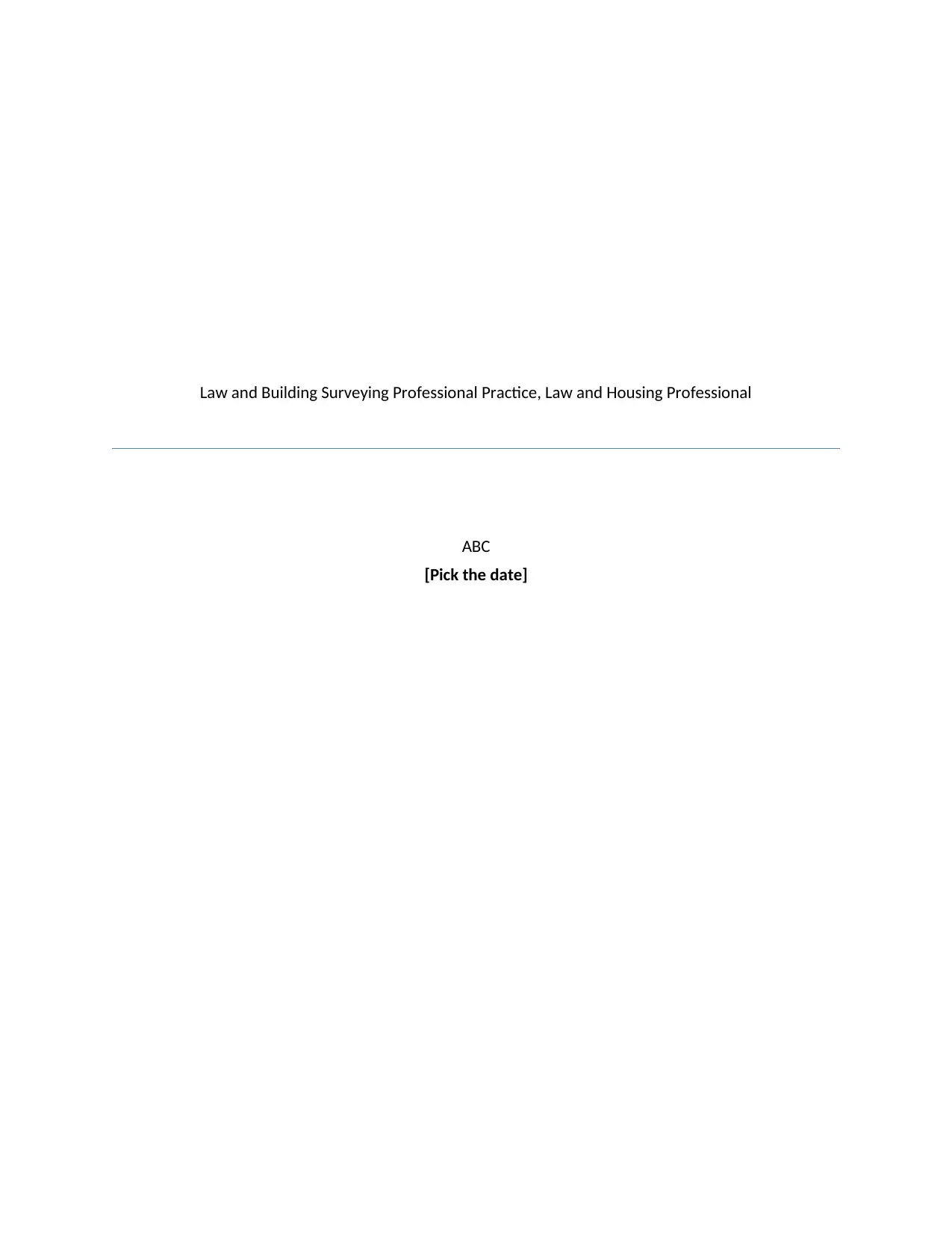
Law and Building Surveying Professional Practice, Law and Housing Professional
ABC
[Pick the date]
ABC
[Pick the date]
Paraphrase This Document
Need a fresh take? Get an instant paraphrase of this document with our AI Paraphraser
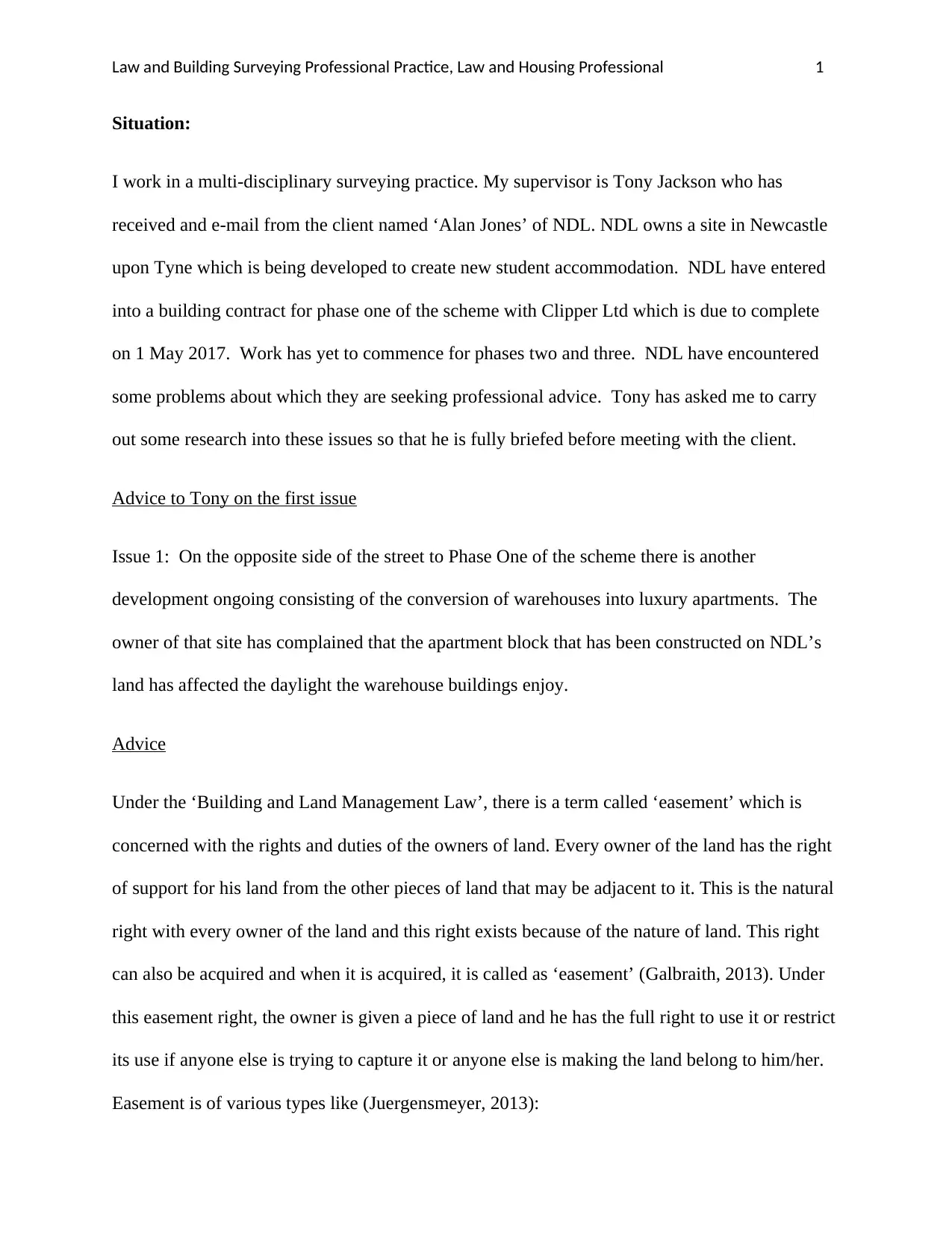
Law and Building Surveying Professional Practice, Law and Housing Professional 1
Situation:
I work in a multi-disciplinary surveying practice. My supervisor is Tony Jackson who has
received and e-mail from the client named ‘Alan Jones’ of NDL. NDL owns a site in Newcastle
upon Tyne which is being developed to create new student accommodation. NDL have entered
into a building contract for phase one of the scheme with Clipper Ltd which is due to complete
on 1 May 2017. Work has yet to commence for phases two and three. NDL have encountered
some problems about which they are seeking professional advice. Tony has asked me to carry
out some research into these issues so that he is fully briefed before meeting with the client.
Advice to Tony on the first issue
Issue 1: On the opposite side of the street to Phase One of the scheme there is another
development ongoing consisting of the conversion of warehouses into luxury apartments. The
owner of that site has complained that the apartment block that has been constructed on NDL’s
land has affected the daylight the warehouse buildings enjoy.
Advice
Under the ‘Building and Land Management Law’, there is a term called ‘easement’ which is
concerned with the rights and duties of the owners of land. Every owner of the land has the right
of support for his land from the other pieces of land that may be adjacent to it. This is the natural
right with every owner of the land and this right exists because of the nature of land. This right
can also be acquired and when it is acquired, it is called as ‘easement’ (Galbraith, 2013). Under
this easement right, the owner is given a piece of land and he has the full right to use it or restrict
its use if anyone else is trying to capture it or anyone else is making the land belong to him/her.
Easement is of various types like (Juergensmeyer, 2013):
Situation:
I work in a multi-disciplinary surveying practice. My supervisor is Tony Jackson who has
received and e-mail from the client named ‘Alan Jones’ of NDL. NDL owns a site in Newcastle
upon Tyne which is being developed to create new student accommodation. NDL have entered
into a building contract for phase one of the scheme with Clipper Ltd which is due to complete
on 1 May 2017. Work has yet to commence for phases two and three. NDL have encountered
some problems about which they are seeking professional advice. Tony has asked me to carry
out some research into these issues so that he is fully briefed before meeting with the client.
Advice to Tony on the first issue
Issue 1: On the opposite side of the street to Phase One of the scheme there is another
development ongoing consisting of the conversion of warehouses into luxury apartments. The
owner of that site has complained that the apartment block that has been constructed on NDL’s
land has affected the daylight the warehouse buildings enjoy.
Advice
Under the ‘Building and Land Management Law’, there is a term called ‘easement’ which is
concerned with the rights and duties of the owners of land. Every owner of the land has the right
of support for his land from the other pieces of land that may be adjacent to it. This is the natural
right with every owner of the land and this right exists because of the nature of land. This right
can also be acquired and when it is acquired, it is called as ‘easement’ (Galbraith, 2013). Under
this easement right, the owner is given a piece of land and he has the full right to use it or restrict
its use if anyone else is trying to capture it or anyone else is making the land belong to him/her.
Easement is of various types like (Juergensmeyer, 2013):
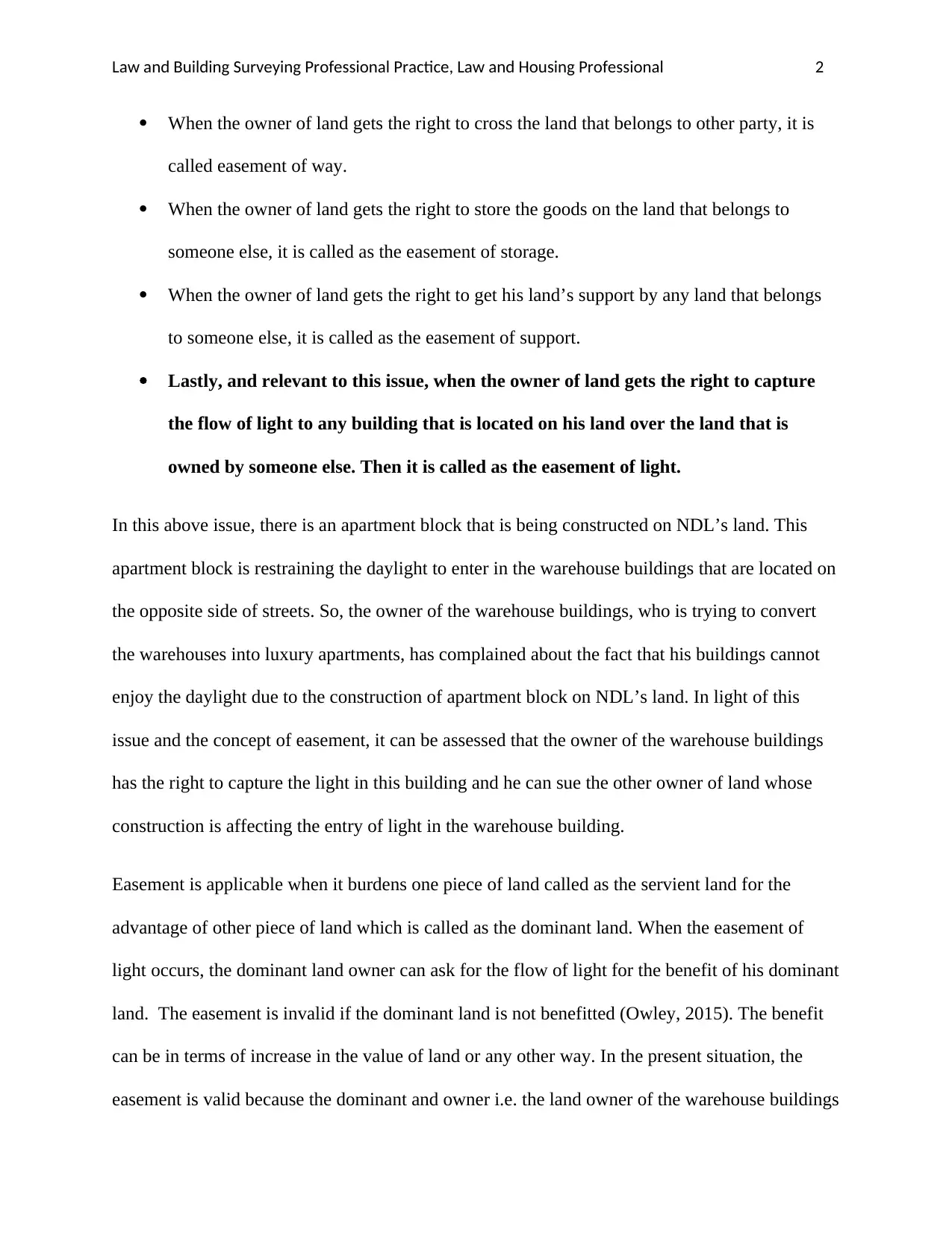
Law and Building Surveying Professional Practice, Law and Housing Professional 2
When the owner of land gets the right to cross the land that belongs to other party, it is
called easement of way.
When the owner of land gets the right to store the goods on the land that belongs to
someone else, it is called as the easement of storage.
When the owner of land gets the right to get his land’s support by any land that belongs
to someone else, it is called as the easement of support.
Lastly, and relevant to this issue, when the owner of land gets the right to capture
the flow of light to any building that is located on his land over the land that is
owned by someone else. Then it is called as the easement of light.
In this above issue, there is an apartment block that is being constructed on NDL’s land. This
apartment block is restraining the daylight to enter in the warehouse buildings that are located on
the opposite side of streets. So, the owner of the warehouse buildings, who is trying to convert
the warehouses into luxury apartments, has complained about the fact that his buildings cannot
enjoy the daylight due to the construction of apartment block on NDL’s land. In light of this
issue and the concept of easement, it can be assessed that the owner of the warehouse buildings
has the right to capture the light in this building and he can sue the other owner of land whose
construction is affecting the entry of light in the warehouse building.
Easement is applicable when it burdens one piece of land called as the servient land for the
advantage of other piece of land which is called as the dominant land. When the easement of
light occurs, the dominant land owner can ask for the flow of light for the benefit of his dominant
land. The easement is invalid if the dominant land is not benefitted (Owley, 2015). The benefit
can be in terms of increase in the value of land or any other way. In the present situation, the
easement is valid because the dominant and owner i.e. the land owner of the warehouse buildings
When the owner of land gets the right to cross the land that belongs to other party, it is
called easement of way.
When the owner of land gets the right to store the goods on the land that belongs to
someone else, it is called as the easement of storage.
When the owner of land gets the right to get his land’s support by any land that belongs
to someone else, it is called as the easement of support.
Lastly, and relevant to this issue, when the owner of land gets the right to capture
the flow of light to any building that is located on his land over the land that is
owned by someone else. Then it is called as the easement of light.
In this above issue, there is an apartment block that is being constructed on NDL’s land. This
apartment block is restraining the daylight to enter in the warehouse buildings that are located on
the opposite side of streets. So, the owner of the warehouse buildings, who is trying to convert
the warehouses into luxury apartments, has complained about the fact that his buildings cannot
enjoy the daylight due to the construction of apartment block on NDL’s land. In light of this
issue and the concept of easement, it can be assessed that the owner of the warehouse buildings
has the right to capture the light in this building and he can sue the other owner of land whose
construction is affecting the entry of light in the warehouse building.
Easement is applicable when it burdens one piece of land called as the servient land for the
advantage of other piece of land which is called as the dominant land. When the easement of
light occurs, the dominant land owner can ask for the flow of light for the benefit of his dominant
land. The easement is invalid if the dominant land is not benefitted (Owley, 2015). The benefit
can be in terms of increase in the value of land or any other way. In the present situation, the
easement is valid because the dominant and owner i.e. the land owner of the warehouse buildings
⊘ This is a preview!⊘
Do you want full access?
Subscribe today to unlock all pages.

Trusted by 1+ million students worldwide
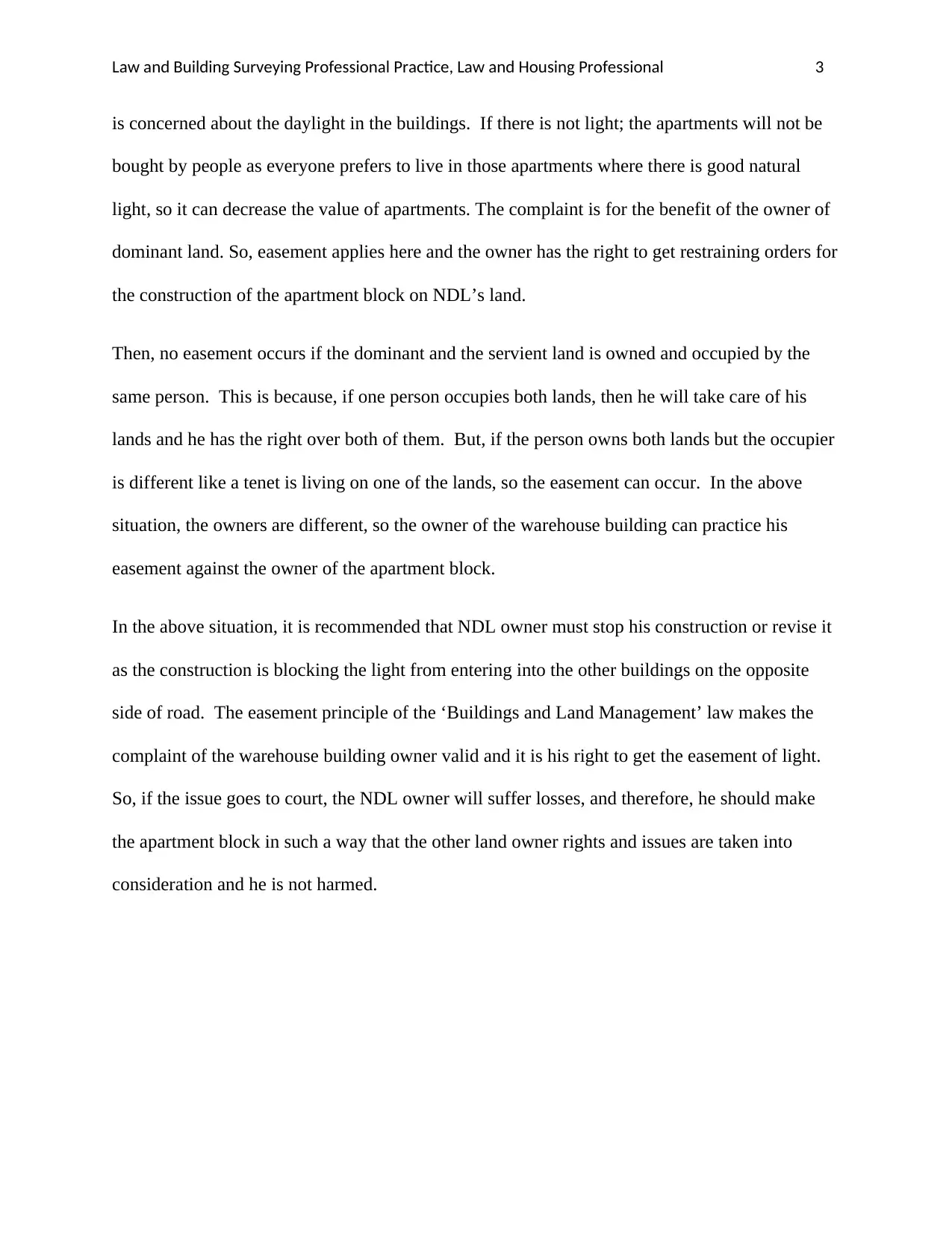
Law and Building Surveying Professional Practice, Law and Housing Professional 3
is concerned about the daylight in the buildings. If there is not light; the apartments will not be
bought by people as everyone prefers to live in those apartments where there is good natural
light, so it can decrease the value of apartments. The complaint is for the benefit of the owner of
dominant land. So, easement applies here and the owner has the right to get restraining orders for
the construction of the apartment block on NDL’s land.
Then, no easement occurs if the dominant and the servient land is owned and occupied by the
same person. This is because, if one person occupies both lands, then he will take care of his
lands and he has the right over both of them. But, if the person owns both lands but the occupier
is different like a tenet is living on one of the lands, so the easement can occur. In the above
situation, the owners are different, so the owner of the warehouse building can practice his
easement against the owner of the apartment block.
In the above situation, it is recommended that NDL owner must stop his construction or revise it
as the construction is blocking the light from entering into the other buildings on the opposite
side of road. The easement principle of the ‘Buildings and Land Management’ law makes the
complaint of the warehouse building owner valid and it is his right to get the easement of light.
So, if the issue goes to court, the NDL owner will suffer losses, and therefore, he should make
the apartment block in such a way that the other land owner rights and issues are taken into
consideration and he is not harmed.
is concerned about the daylight in the buildings. If there is not light; the apartments will not be
bought by people as everyone prefers to live in those apartments where there is good natural
light, so it can decrease the value of apartments. The complaint is for the benefit of the owner of
dominant land. So, easement applies here and the owner has the right to get restraining orders for
the construction of the apartment block on NDL’s land.
Then, no easement occurs if the dominant and the servient land is owned and occupied by the
same person. This is because, if one person occupies both lands, then he will take care of his
lands and he has the right over both of them. But, if the person owns both lands but the occupier
is different like a tenet is living on one of the lands, so the easement can occur. In the above
situation, the owners are different, so the owner of the warehouse building can practice his
easement against the owner of the apartment block.
In the above situation, it is recommended that NDL owner must stop his construction or revise it
as the construction is blocking the light from entering into the other buildings on the opposite
side of road. The easement principle of the ‘Buildings and Land Management’ law makes the
complaint of the warehouse building owner valid and it is his right to get the easement of light.
So, if the issue goes to court, the NDL owner will suffer losses, and therefore, he should make
the apartment block in such a way that the other land owner rights and issues are taken into
consideration and he is not harmed.
Paraphrase This Document
Need a fresh take? Get an instant paraphrase of this document with our AI Paraphraser
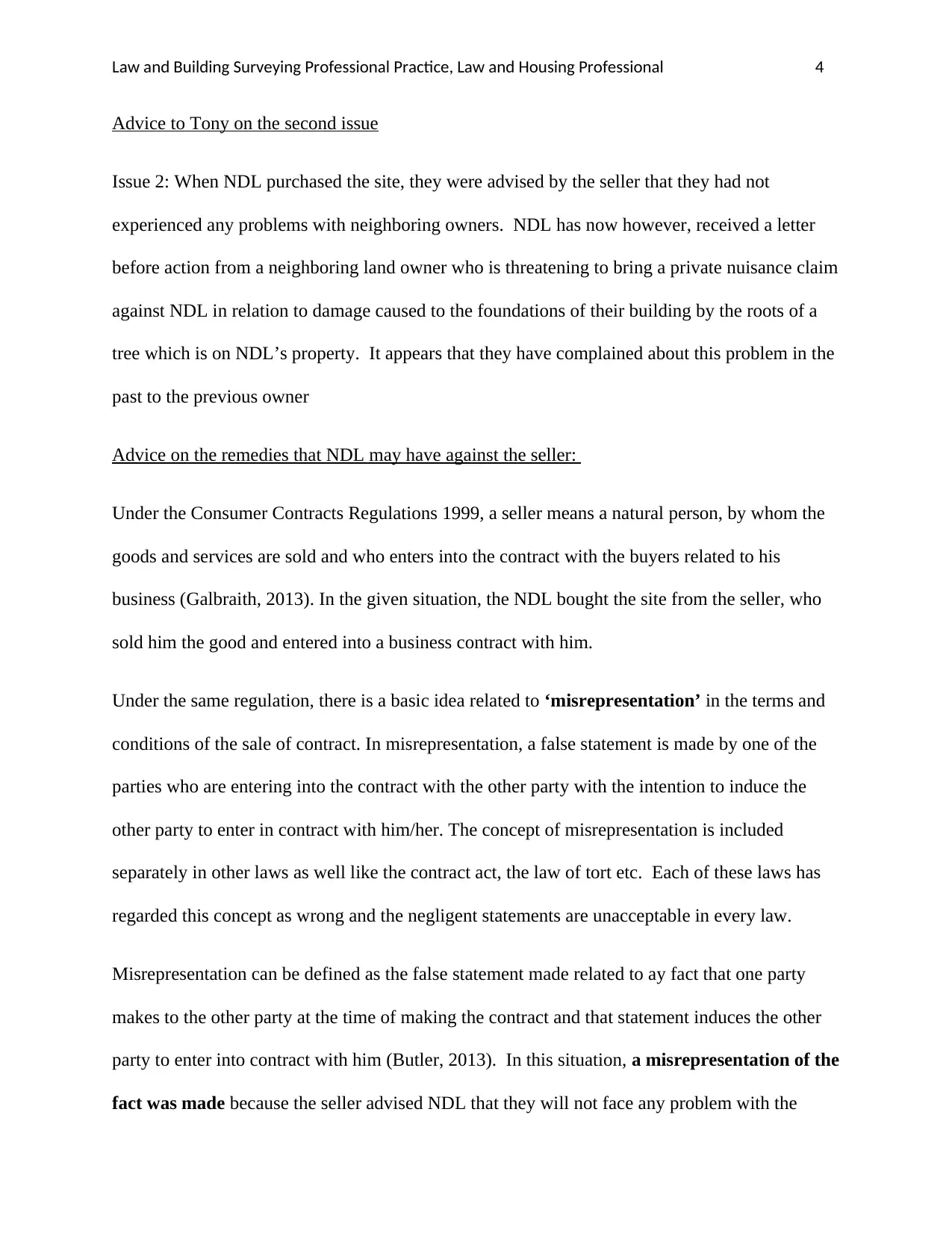
Law and Building Surveying Professional Practice, Law and Housing Professional 4
Advice to Tony on the second issue
Issue 2: When NDL purchased the site, they were advised by the seller that they had not
experienced any problems with neighboring owners. NDL has now however, received a letter
before action from a neighboring land owner who is threatening to bring a private nuisance claim
against NDL in relation to damage caused to the foundations of their building by the roots of a
tree which is on NDL’s property. It appears that they have complained about this problem in the
past to the previous owner
Advice on the remedies that NDL may have against the seller:
Under the Consumer Contracts Regulations 1999, a seller means a natural person, by whom the
goods and services are sold and who enters into the contract with the buyers related to his
business (Galbraith, 2013). In the given situation, the NDL bought the site from the seller, who
sold him the good and entered into a business contract with him.
Under the same regulation, there is a basic idea related to ‘misrepresentation’ in the terms and
conditions of the sale of contract. In misrepresentation, a false statement is made by one of the
parties who are entering into the contract with the other party with the intention to induce the
other party to enter in contract with him/her. The concept of misrepresentation is included
separately in other laws as well like the contract act, the law of tort etc. Each of these laws has
regarded this concept as wrong and the negligent statements are unacceptable in every law.
Misrepresentation can be defined as the false statement made related to ay fact that one party
makes to the other party at the time of making the contract and that statement induces the other
party to enter into contract with him (Butler, 2013). In this situation, a misrepresentation of the
fact was made because the seller advised NDL that they will not face any problem with the
Advice to Tony on the second issue
Issue 2: When NDL purchased the site, they were advised by the seller that they had not
experienced any problems with neighboring owners. NDL has now however, received a letter
before action from a neighboring land owner who is threatening to bring a private nuisance claim
against NDL in relation to damage caused to the foundations of their building by the roots of a
tree which is on NDL’s property. It appears that they have complained about this problem in the
past to the previous owner
Advice on the remedies that NDL may have against the seller:
Under the Consumer Contracts Regulations 1999, a seller means a natural person, by whom the
goods and services are sold and who enters into the contract with the buyers related to his
business (Galbraith, 2013). In the given situation, the NDL bought the site from the seller, who
sold him the good and entered into a business contract with him.
Under the same regulation, there is a basic idea related to ‘misrepresentation’ in the terms and
conditions of the sale of contract. In misrepresentation, a false statement is made by one of the
parties who are entering into the contract with the other party with the intention to induce the
other party to enter in contract with him/her. The concept of misrepresentation is included
separately in other laws as well like the contract act, the law of tort etc. Each of these laws has
regarded this concept as wrong and the negligent statements are unacceptable in every law.
Misrepresentation can be defined as the false statement made related to ay fact that one party
makes to the other party at the time of making the contract and that statement induces the other
party to enter into contract with him (Butler, 2013). In this situation, a misrepresentation of the
fact was made because the seller advised NDL that they will not face any problem with the
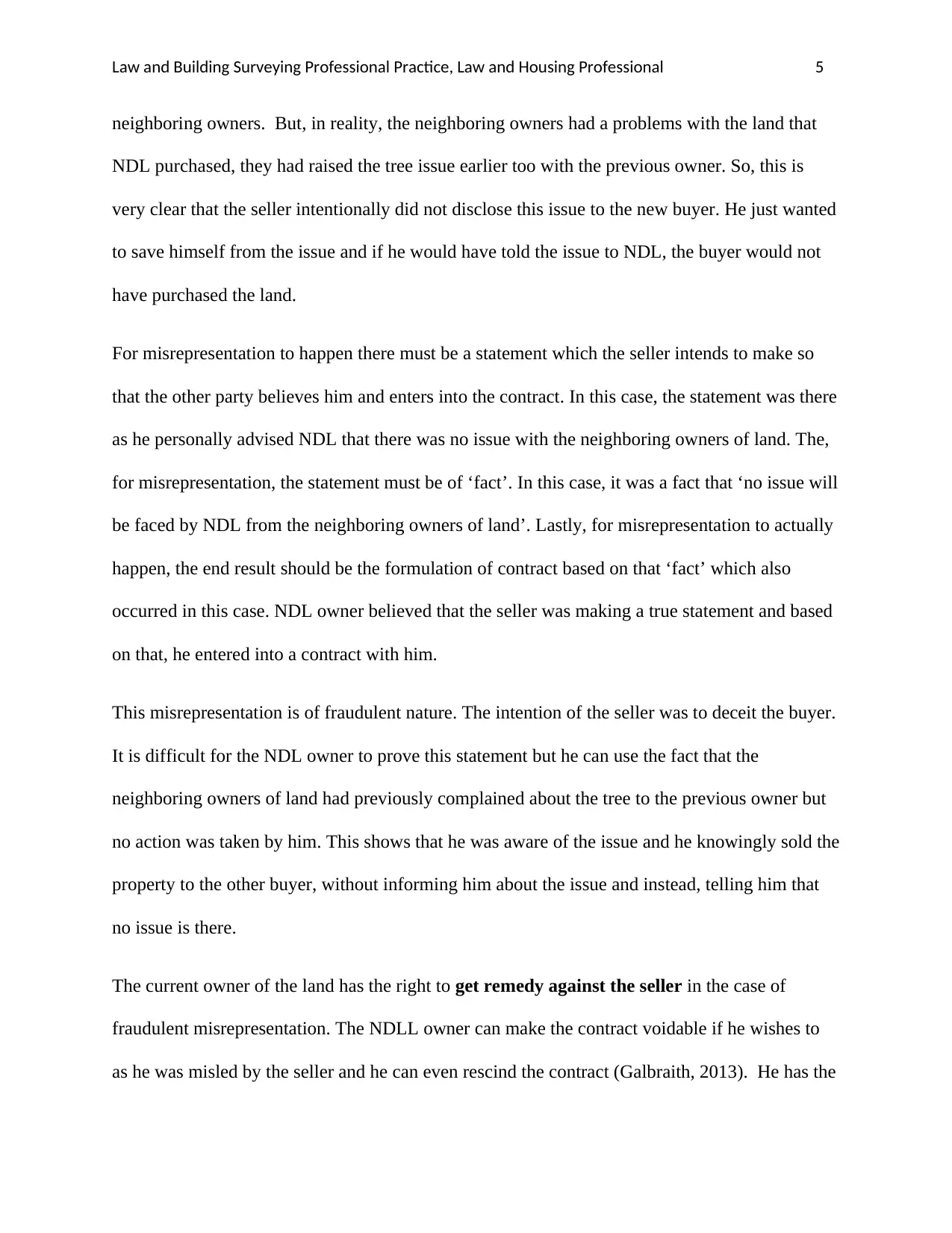
Law and Building Surveying Professional Practice, Law and Housing Professional 5
neighboring owners. But, in reality, the neighboring owners had a problems with the land that
NDL purchased, they had raised the tree issue earlier too with the previous owner. So, this is
very clear that the seller intentionally did not disclose this issue to the new buyer. He just wanted
to save himself from the issue and if he would have told the issue to NDL, the buyer would not
have purchased the land.
For misrepresentation to happen there must be a statement which the seller intends to make so
that the other party believes him and enters into the contract. In this case, the statement was there
as he personally advised NDL that there was no issue with the neighboring owners of land. The,
for misrepresentation, the statement must be of ‘fact’. In this case, it was a fact that ‘no issue will
be faced by NDL from the neighboring owners of land’. Lastly, for misrepresentation to actually
happen, the end result should be the formulation of contract based on that ‘fact’ which also
occurred in this case. NDL owner believed that the seller was making a true statement and based
on that, he entered into a contract with him.
This misrepresentation is of fraudulent nature. The intention of the seller was to deceit the buyer.
It is difficult for the NDL owner to prove this statement but he can use the fact that the
neighboring owners of land had previously complained about the tree to the previous owner but
no action was taken by him. This shows that he was aware of the issue and he knowingly sold the
property to the other buyer, without informing him about the issue and instead, telling him that
no issue is there.
The current owner of the land has the right to get remedy against the seller in the case of
fraudulent misrepresentation. The NDLL owner can make the contract voidable if he wishes to
as he was misled by the seller and he can even rescind the contract (Galbraith, 2013). He has the
neighboring owners. But, in reality, the neighboring owners had a problems with the land that
NDL purchased, they had raised the tree issue earlier too with the previous owner. So, this is
very clear that the seller intentionally did not disclose this issue to the new buyer. He just wanted
to save himself from the issue and if he would have told the issue to NDL, the buyer would not
have purchased the land.
For misrepresentation to happen there must be a statement which the seller intends to make so
that the other party believes him and enters into the contract. In this case, the statement was there
as he personally advised NDL that there was no issue with the neighboring owners of land. The,
for misrepresentation, the statement must be of ‘fact’. In this case, it was a fact that ‘no issue will
be faced by NDL from the neighboring owners of land’. Lastly, for misrepresentation to actually
happen, the end result should be the formulation of contract based on that ‘fact’ which also
occurred in this case. NDL owner believed that the seller was making a true statement and based
on that, he entered into a contract with him.
This misrepresentation is of fraudulent nature. The intention of the seller was to deceit the buyer.
It is difficult for the NDL owner to prove this statement but he can use the fact that the
neighboring owners of land had previously complained about the tree to the previous owner but
no action was taken by him. This shows that he was aware of the issue and he knowingly sold the
property to the other buyer, without informing him about the issue and instead, telling him that
no issue is there.
The current owner of the land has the right to get remedy against the seller in the case of
fraudulent misrepresentation. The NDLL owner can make the contract voidable if he wishes to
as he was misled by the seller and he can even rescind the contract (Galbraith, 2013). He has the
⊘ This is a preview!⊘
Do you want full access?
Subscribe today to unlock all pages.

Trusted by 1+ million students worldwide
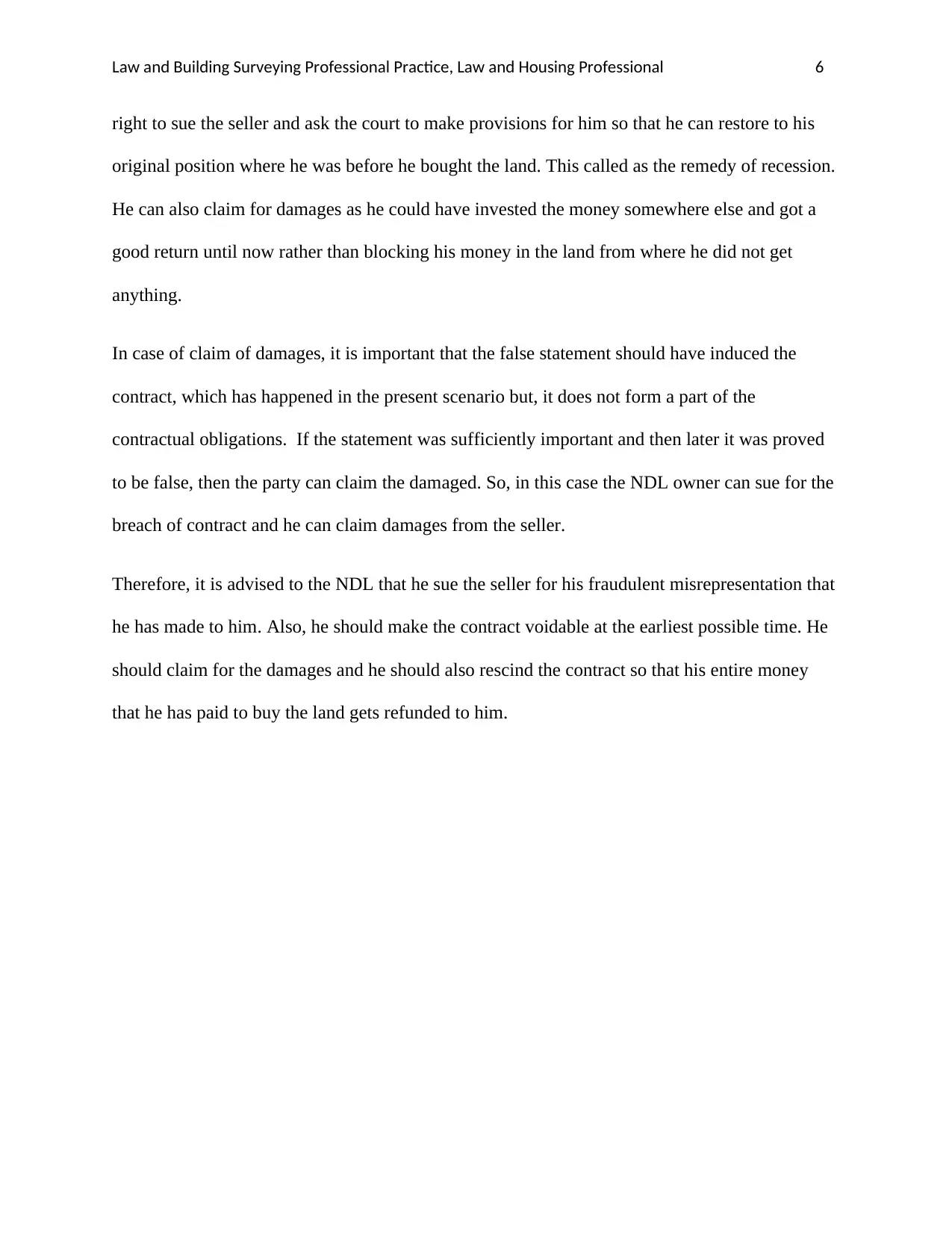
Law and Building Surveying Professional Practice, Law and Housing Professional 6
right to sue the seller and ask the court to make provisions for him so that he can restore to his
original position where he was before he bought the land. This called as the remedy of recession.
He can also claim for damages as he could have invested the money somewhere else and got a
good return until now rather than blocking his money in the land from where he did not get
anything.
In case of claim of damages, it is important that the false statement should have induced the
contract, which has happened in the present scenario but, it does not form a part of the
contractual obligations. If the statement was sufficiently important and then later it was proved
to be false, then the party can claim the damaged. So, in this case the NDL owner can sue for the
breach of contract and he can claim damages from the seller.
Therefore, it is advised to the NDL that he sue the seller for his fraudulent misrepresentation that
he has made to him. Also, he should make the contract voidable at the earliest possible time. He
should claim for the damages and he should also rescind the contract so that his entire money
that he has paid to buy the land gets refunded to him.
right to sue the seller and ask the court to make provisions for him so that he can restore to his
original position where he was before he bought the land. This called as the remedy of recession.
He can also claim for damages as he could have invested the money somewhere else and got a
good return until now rather than blocking his money in the land from where he did not get
anything.
In case of claim of damages, it is important that the false statement should have induced the
contract, which has happened in the present scenario but, it does not form a part of the
contractual obligations. If the statement was sufficiently important and then later it was proved
to be false, then the party can claim the damaged. So, in this case the NDL owner can sue for the
breach of contract and he can claim damages from the seller.
Therefore, it is advised to the NDL that he sue the seller for his fraudulent misrepresentation that
he has made to him. Also, he should make the contract voidable at the earliest possible time. He
should claim for the damages and he should also rescind the contract so that his entire money
that he has paid to buy the land gets refunded to him.
Paraphrase This Document
Need a fresh take? Get an instant paraphrase of this document with our AI Paraphraser
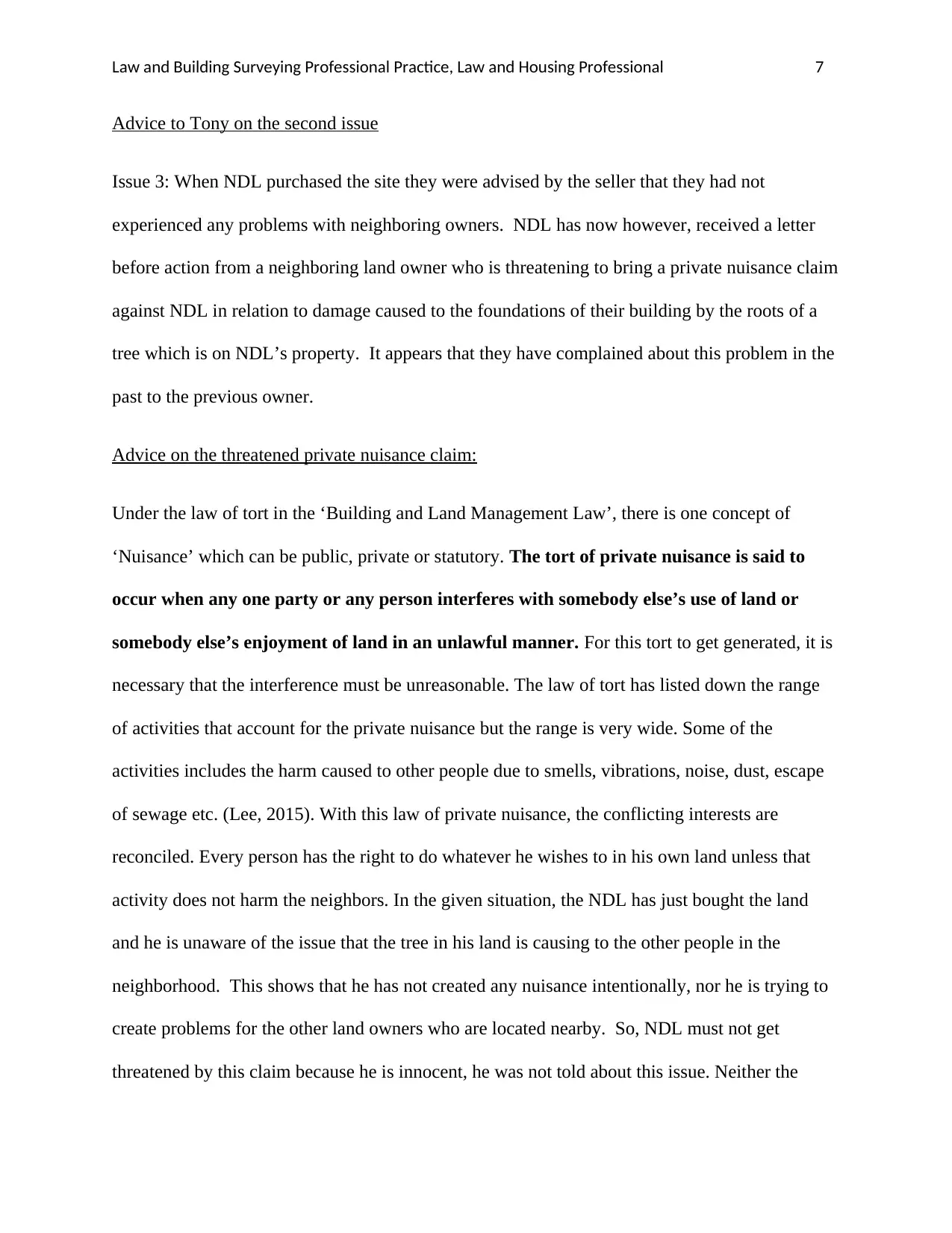
Law and Building Surveying Professional Practice, Law and Housing Professional 7
Advice to Tony on the second issue
Issue 3: When NDL purchased the site they were advised by the seller that they had not
experienced any problems with neighboring owners. NDL has now however, received a letter
before action from a neighboring land owner who is threatening to bring a private nuisance claim
against NDL in relation to damage caused to the foundations of their building by the roots of a
tree which is on NDL’s property. It appears that they have complained about this problem in the
past to the previous owner.
Advice on the threatened private nuisance claim:
Under the law of tort in the ‘Building and Land Management Law’, there is one concept of
‘Nuisance’ which can be public, private or statutory. The tort of private nuisance is said to
occur when any one party or any person interferes with somebody else’s use of land or
somebody else’s enjoyment of land in an unlawful manner. For this tort to get generated, it is
necessary that the interference must be unreasonable. The law of tort has listed down the range
of activities that account for the private nuisance but the range is very wide. Some of the
activities includes the harm caused to other people due to smells, vibrations, noise, dust, escape
of sewage etc. (Lee, 2015). With this law of private nuisance, the conflicting interests are
reconciled. Every person has the right to do whatever he wishes to in his own land unless that
activity does not harm the neighbors. In the given situation, the NDL has just bought the land
and he is unaware of the issue that the tree in his land is causing to the other people in the
neighborhood. This shows that he has not created any nuisance intentionally, nor he is trying to
create problems for the other land owners who are located nearby. So, NDL must not get
threatened by this claim because he is innocent, he was not told about this issue. Neither the
Advice to Tony on the second issue
Issue 3: When NDL purchased the site they were advised by the seller that they had not
experienced any problems with neighboring owners. NDL has now however, received a letter
before action from a neighboring land owner who is threatening to bring a private nuisance claim
against NDL in relation to damage caused to the foundations of their building by the roots of a
tree which is on NDL’s property. It appears that they have complained about this problem in the
past to the previous owner.
Advice on the threatened private nuisance claim:
Under the law of tort in the ‘Building and Land Management Law’, there is one concept of
‘Nuisance’ which can be public, private or statutory. The tort of private nuisance is said to
occur when any one party or any person interferes with somebody else’s use of land or
somebody else’s enjoyment of land in an unlawful manner. For this tort to get generated, it is
necessary that the interference must be unreasonable. The law of tort has listed down the range
of activities that account for the private nuisance but the range is very wide. Some of the
activities includes the harm caused to other people due to smells, vibrations, noise, dust, escape
of sewage etc. (Lee, 2015). With this law of private nuisance, the conflicting interests are
reconciled. Every person has the right to do whatever he wishes to in his own land unless that
activity does not harm the neighbors. In the given situation, the NDL has just bought the land
and he is unaware of the issue that the tree in his land is causing to the other people in the
neighborhood. This shows that he has not created any nuisance intentionally, nor he is trying to
create problems for the other land owners who are located nearby. So, NDL must not get
threatened by this claim because he is innocent, he was not told about this issue. Neither the
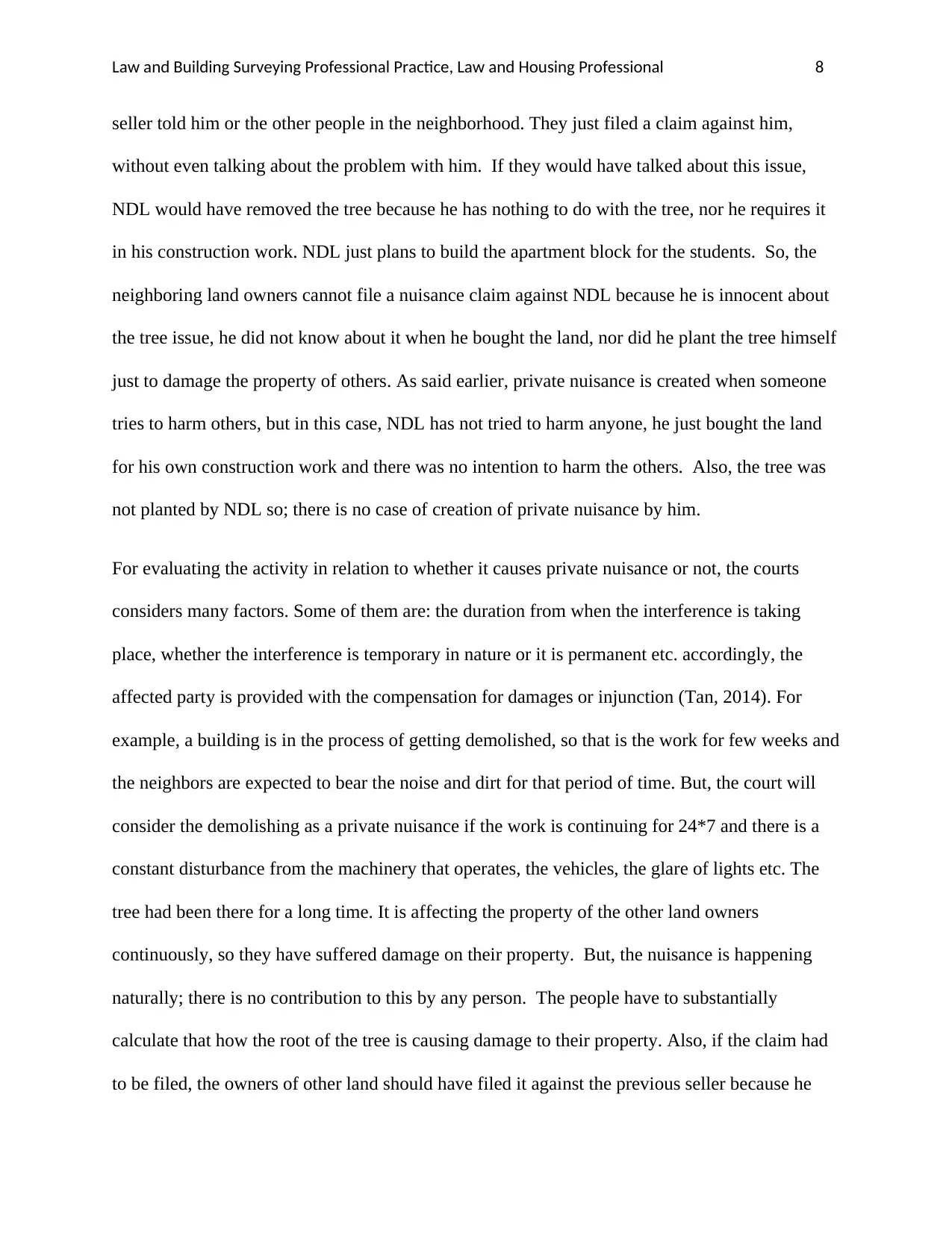
Law and Building Surveying Professional Practice, Law and Housing Professional 8
seller told him or the other people in the neighborhood. They just filed a claim against him,
without even talking about the problem with him. If they would have talked about this issue,
NDL would have removed the tree because he has nothing to do with the tree, nor he requires it
in his construction work. NDL just plans to build the apartment block for the students. So, the
neighboring land owners cannot file a nuisance claim against NDL because he is innocent about
the tree issue, he did not know about it when he bought the land, nor did he plant the tree himself
just to damage the property of others. As said earlier, private nuisance is created when someone
tries to harm others, but in this case, NDL has not tried to harm anyone, he just bought the land
for his own construction work and there was no intention to harm the others. Also, the tree was
not planted by NDL so; there is no case of creation of private nuisance by him.
For evaluating the activity in relation to whether it causes private nuisance or not, the courts
considers many factors. Some of them are: the duration from when the interference is taking
place, whether the interference is temporary in nature or it is permanent etc. accordingly, the
affected party is provided with the compensation for damages or injunction (Tan, 2014). For
example, a building is in the process of getting demolished, so that is the work for few weeks and
the neighbors are expected to bear the noise and dirt for that period of time. But, the court will
consider the demolishing as a private nuisance if the work is continuing for 24*7 and there is a
constant disturbance from the machinery that operates, the vehicles, the glare of lights etc. The
tree had been there for a long time. It is affecting the property of the other land owners
continuously, so they have suffered damage on their property. But, the nuisance is happening
naturally; there is no contribution to this by any person. The people have to substantially
calculate that how the root of the tree is causing damage to their property. Also, if the claim had
to be filed, the owners of other land should have filed it against the previous seller because he
seller told him or the other people in the neighborhood. They just filed a claim against him,
without even talking about the problem with him. If they would have talked about this issue,
NDL would have removed the tree because he has nothing to do with the tree, nor he requires it
in his construction work. NDL just plans to build the apartment block for the students. So, the
neighboring land owners cannot file a nuisance claim against NDL because he is innocent about
the tree issue, he did not know about it when he bought the land, nor did he plant the tree himself
just to damage the property of others. As said earlier, private nuisance is created when someone
tries to harm others, but in this case, NDL has not tried to harm anyone, he just bought the land
for his own construction work and there was no intention to harm the others. Also, the tree was
not planted by NDL so; there is no case of creation of private nuisance by him.
For evaluating the activity in relation to whether it causes private nuisance or not, the courts
considers many factors. Some of them are: the duration from when the interference is taking
place, whether the interference is temporary in nature or it is permanent etc. accordingly, the
affected party is provided with the compensation for damages or injunction (Tan, 2014). For
example, a building is in the process of getting demolished, so that is the work for few weeks and
the neighbors are expected to bear the noise and dirt for that period of time. But, the court will
consider the demolishing as a private nuisance if the work is continuing for 24*7 and there is a
constant disturbance from the machinery that operates, the vehicles, the glare of lights etc. The
tree had been there for a long time. It is affecting the property of the other land owners
continuously, so they have suffered damage on their property. But, the nuisance is happening
naturally; there is no contribution to this by any person. The people have to substantially
calculate that how the root of the tree is causing damage to their property. Also, if the claim had
to be filed, the owners of other land should have filed it against the previous seller because he
⊘ This is a preview!⊘
Do you want full access?
Subscribe today to unlock all pages.

Trusted by 1+ million students worldwide
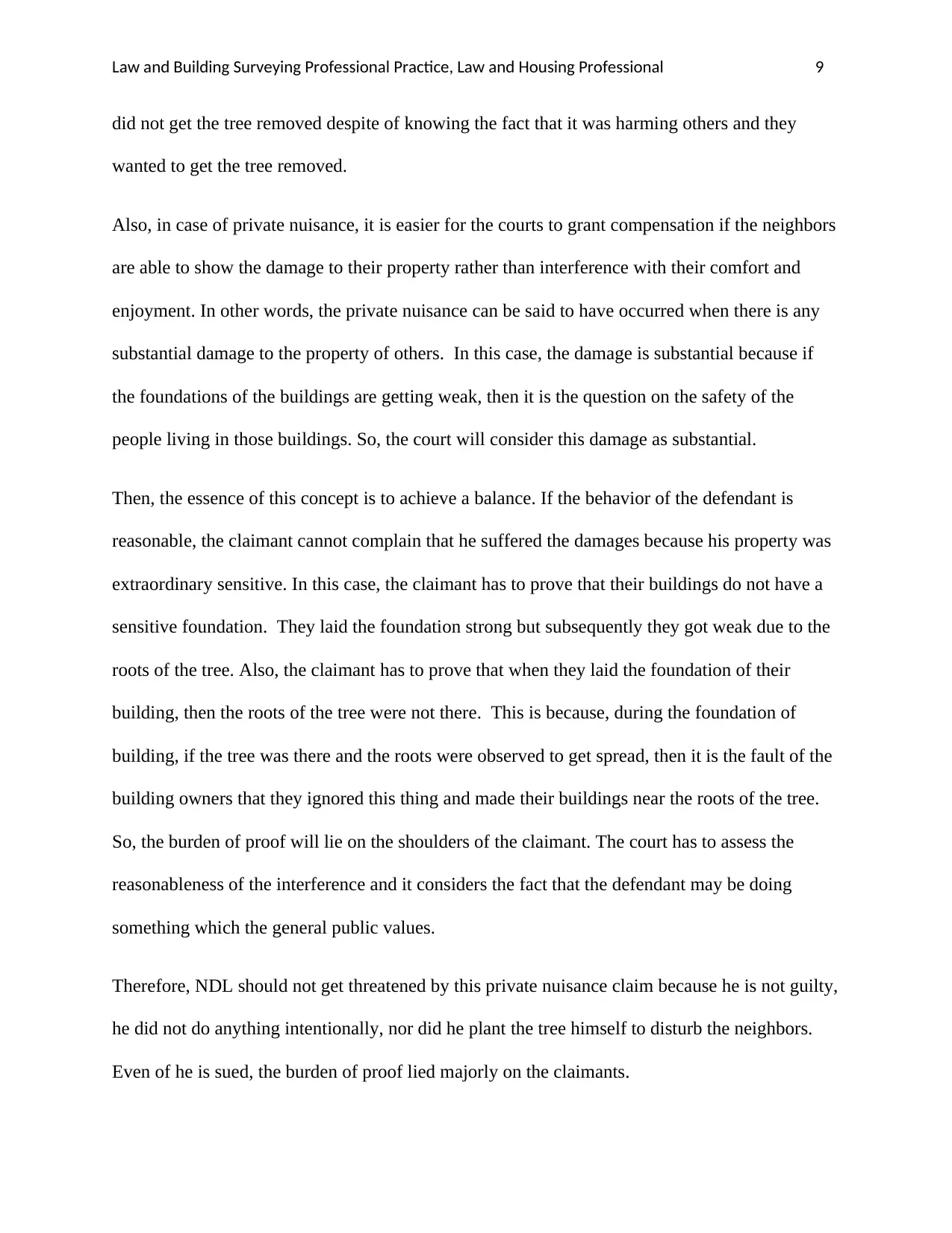
Law and Building Surveying Professional Practice, Law and Housing Professional 9
did not get the tree removed despite of knowing the fact that it was harming others and they
wanted to get the tree removed.
Also, in case of private nuisance, it is easier for the courts to grant compensation if the neighbors
are able to show the damage to their property rather than interference with their comfort and
enjoyment. In other words, the private nuisance can be said to have occurred when there is any
substantial damage to the property of others. In this case, the damage is substantial because if
the foundations of the buildings are getting weak, then it is the question on the safety of the
people living in those buildings. So, the court will consider this damage as substantial.
Then, the essence of this concept is to achieve a balance. If the behavior of the defendant is
reasonable, the claimant cannot complain that he suffered the damages because his property was
extraordinary sensitive. In this case, the claimant has to prove that their buildings do not have a
sensitive foundation. They laid the foundation strong but subsequently they got weak due to the
roots of the tree. Also, the claimant has to prove that when they laid the foundation of their
building, then the roots of the tree were not there. This is because, during the foundation of
building, if the tree was there and the roots were observed to get spread, then it is the fault of the
building owners that they ignored this thing and made their buildings near the roots of the tree.
So, the burden of proof will lie on the shoulders of the claimant. The court has to assess the
reasonableness of the interference and it considers the fact that the defendant may be doing
something which the general public values.
Therefore, NDL should not get threatened by this private nuisance claim because he is not guilty,
he did not do anything intentionally, nor did he plant the tree himself to disturb the neighbors.
Even of he is sued, the burden of proof lied majorly on the claimants.
did not get the tree removed despite of knowing the fact that it was harming others and they
wanted to get the tree removed.
Also, in case of private nuisance, it is easier for the courts to grant compensation if the neighbors
are able to show the damage to their property rather than interference with their comfort and
enjoyment. In other words, the private nuisance can be said to have occurred when there is any
substantial damage to the property of others. In this case, the damage is substantial because if
the foundations of the buildings are getting weak, then it is the question on the safety of the
people living in those buildings. So, the court will consider this damage as substantial.
Then, the essence of this concept is to achieve a balance. If the behavior of the defendant is
reasonable, the claimant cannot complain that he suffered the damages because his property was
extraordinary sensitive. In this case, the claimant has to prove that their buildings do not have a
sensitive foundation. They laid the foundation strong but subsequently they got weak due to the
roots of the tree. Also, the claimant has to prove that when they laid the foundation of their
building, then the roots of the tree were not there. This is because, during the foundation of
building, if the tree was there and the roots were observed to get spread, then it is the fault of the
building owners that they ignored this thing and made their buildings near the roots of the tree.
So, the burden of proof will lie on the shoulders of the claimant. The court has to assess the
reasonableness of the interference and it considers the fact that the defendant may be doing
something which the general public values.
Therefore, NDL should not get threatened by this private nuisance claim because he is not guilty,
he did not do anything intentionally, nor did he plant the tree himself to disturb the neighbors.
Even of he is sued, the burden of proof lied majorly on the claimants.
Paraphrase This Document
Need a fresh take? Get an instant paraphrase of this document with our AI Paraphraser
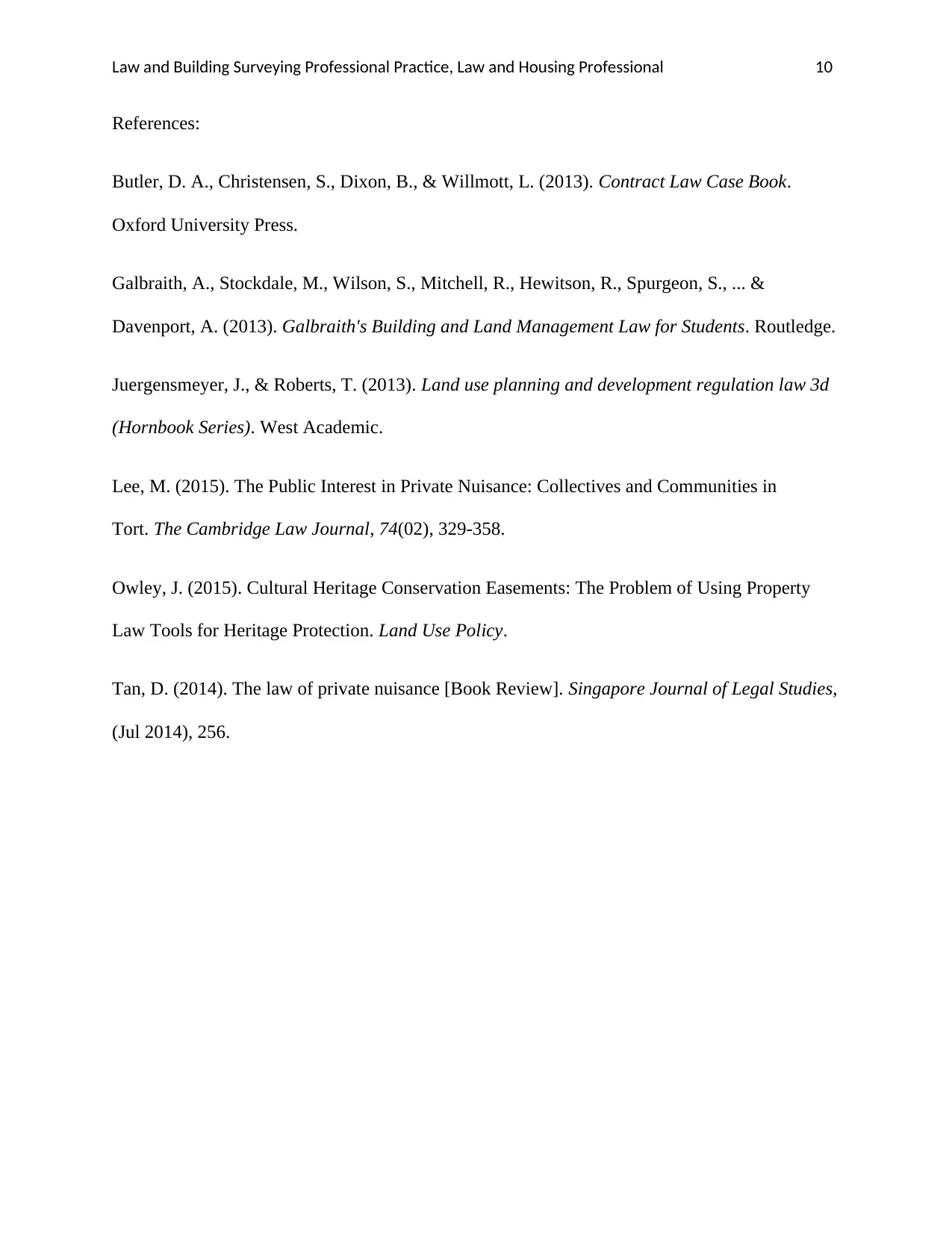
Law and Building Surveying Professional Practice, Law and Housing Professional 10
References:
Butler, D. A., Christensen, S., Dixon, B., & Willmott, L. (2013). Contract Law Case Book.
Oxford University Press.
Galbraith, A., Stockdale, M., Wilson, S., Mitchell, R., Hewitson, R., Spurgeon, S., ... &
Davenport, A. (2013). Galbraith's Building and Land Management Law for Students. Routledge.
Juergensmeyer, J., & Roberts, T. (2013). Land use planning and development regulation law 3d
(Hornbook Series). West Academic.
Lee, M. (2015). The Public Interest in Private Nuisance: Collectives and Communities in
Tort. The Cambridge Law Journal, 74(02), 329-358.
Owley, J. (2015). Cultural Heritage Conservation Easements: The Problem of Using Property
Law Tools for Heritage Protection. Land Use Policy.
Tan, D. (2014). The law of private nuisance [Book Review]. Singapore Journal of Legal Studies,
(Jul 2014), 256.
References:
Butler, D. A., Christensen, S., Dixon, B., & Willmott, L. (2013). Contract Law Case Book.
Oxford University Press.
Galbraith, A., Stockdale, M., Wilson, S., Mitchell, R., Hewitson, R., Spurgeon, S., ... &
Davenport, A. (2013). Galbraith's Building and Land Management Law for Students. Routledge.
Juergensmeyer, J., & Roberts, T. (2013). Land use planning and development regulation law 3d
(Hornbook Series). West Academic.
Lee, M. (2015). The Public Interest in Private Nuisance: Collectives and Communities in
Tort. The Cambridge Law Journal, 74(02), 329-358.
Owley, J. (2015). Cultural Heritage Conservation Easements: The Problem of Using Property
Law Tools for Heritage Protection. Land Use Policy.
Tan, D. (2014). The law of private nuisance [Book Review]. Singapore Journal of Legal Studies,
(Jul 2014), 256.
1 out of 11
Related Documents
Your All-in-One AI-Powered Toolkit for Academic Success.
+13062052269
info@desklib.com
Available 24*7 on WhatsApp / Email
![[object Object]](/_next/static/media/star-bottom.7253800d.svg)
Unlock your academic potential
Copyright © 2020–2025 A2Z Services. All Rights Reserved. Developed and managed by ZUCOL.





